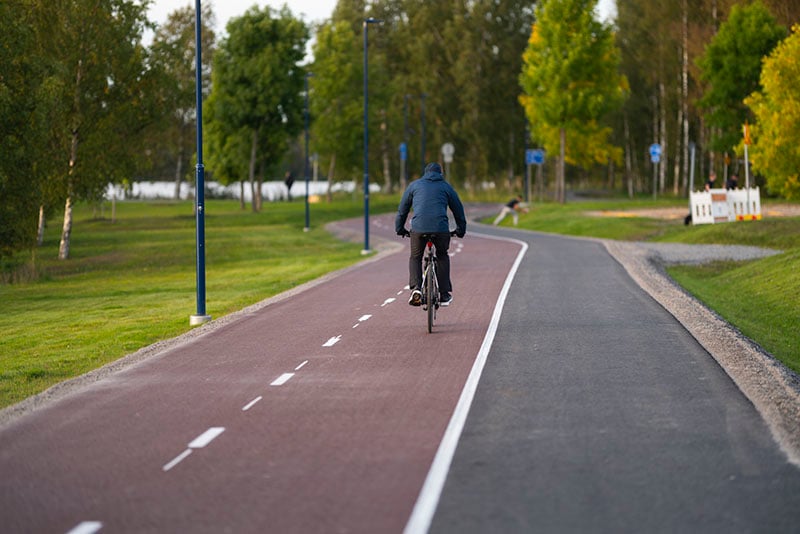Vaasa Experiment: Can cycle paths become carbon sinks?
Vaasa has set a strict goal to reach carbon neutrality as soon as at the end of the current decade. One way to do this is to encourage people to cycle and walk. This is promoted by a cycling project, which aims to create a 50-kilometre network of walking and cycling routes in Vaasa.
Extra points for innovation
The Pyörällä Päästään Alliance is in charge of implementing the network. When the City of Vaasa was looking for alliance partners in 2022, the bid of the winners – GRK Suomi Oy and Sitowise Oyj – scored extra points with their innovative idea.
"The offer included a proposal to use biochar, and we found the idea of turning cycle paths into carbon sinks interesting and worth trying," says Jukka Talvi, Director of Municipal Engineering at Vaasa.
"The idea is also an answer to our thoughts on reducing the carbon footprint at construction sites. We had not even thought that construction sites could be turned into carbon sinks using a material that binds carbon to structures,” says Project Engineer Samuli Huusko.
From seaside paths to the world
The trial area is on the cycle path at Gerbyn rantatie, from which we have chosen the areas with the worst frost cracks. As the path is renovated, we will trial the use of biochar in road structures. One of the key objectives is to find out whether the use of biochar has an impact on road frost damage.
"The bottom layer structure of the cycle path will consist of 1 to 5 centimeters of biochar, which should not have major negative effects. The possibility to bind carbon to structures should push the scale to the positive side,” says Huusko.
Frost damage is a problem at these latitudes, but measurements and experiences that we can gain from this project become valuable knowledge and skills that can be applied more widely.
“We hope that the project succeeds, which would make it easy to replicate elsewhere. I believe that this concept could be applied to other types of roads.
We aim to be an example, both nationally and internationally – this can be an opportunity to implement similar projects on a global scale, Huusko envisions.

Opening of the Gerby path corridor on 18 September 2023.
Companies and municipalities innovate together
For Business Finland, the project in the Vaasa region and the alliance's activities demonstrate how the funding and other assistance it provides can be used to promote cooperation and innovative procurement between cities and companies.
"This is a prime example of a project where the city provides a piloting environment and companies gain an important reference through the partnership with the city and the results generated thereof, and any possible new solutions," says Riikka Munne, Financing Specialist at Business Finland.
Business Finland wants to encourage procurement units in the public sector to intensify dialogue and cooperation with companies and to use innovative procurement as a means to expand the market and accelerate companies' RDI activities.
"With sufficiently ambitious objectives and commitment, partnerships can contribute to the development of solutions with export potential. Business Finland can contribute funding to bear the risk of innovative procurement, directed at the development of new solutions,” Munne comments.
Business Finland is a participant in the KEINO network, which is a network-like center of competence for sustainable and innovative public procurement and provides free services to contracting entities. That is where the City of Vaasa has also received support for implementing their innovative procurements.
Providing funding and assistance
Business Finland's role in the biochar project is to provide funding and thus share the risk of developing a new solution. The project received EUR 100,000 of EU RRF funding from Business Finland as part of the Low Carbon Built Environment Program. The other EUR 100,000 is sourced from the City of Vaasa's budget.
Samuli Huusko encourages parties that are considering innovation projects to think about different funding opportunities, as funding is available. Jukka Talvi also emphasizes the help and sparring they received from Business Finland in financing matters, from the preliminary assessment of the application to payment.
Cooperation with networks and Business Finland is incredibly valuable.
"A city the size of Vaasa might not be able to develop international-level methods such as this with its own money. That is why cooperation with networks and Business Finland is incredibly valuable,” Talvi says.
Funding for innovative public procurements is targeted at the planning, tendering and development phases of the procurement. It is also possible, for example, to finance procurement units’ innovative joint procurement projects.
"Developing a new solution that is scalable to the needs of multiple customers will benefit both the implementing supplier and the procurement units," Munne says.
Read more about the Decarbonized Cities Program
#SustainableGrowth
